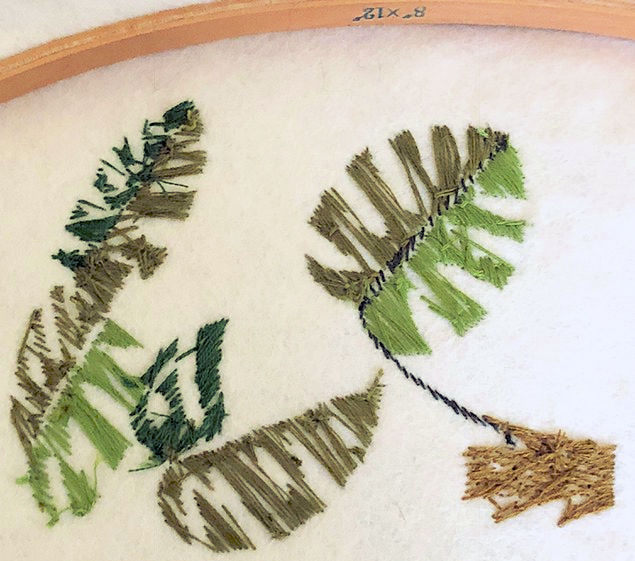Satin stitch sems to be a very popular stitch at the moment, featuring in lots of the lovely designs I’ve been seeing lately. You might think that satin stitch is an incredibly easy stitch to sew – after all you just go in and out, out and in, from one side of the shape to another – and in one sense you’d be absolutely right. But satin stitch is in fact rather like the English language……

According to my Russian friend Elona who was once heard to remark … “English is a very easy language to pick up the basics, but a very difficult language to speak well.” And I think the same is probably true of satin stitch, so I thought I’d share a few tips here with you today – though I am by no means suggesting I’m an expert, or that this is a fully inclusive list – these are just hints that my mum and grandma passed onto me….
1. Use a good quality floss. You won’t get good results with any kind of stitch if you’re using cheap floss that breaks and tangles and is horrible to work with.
2. I usually like to work with two strands, and personally would be unlikely to use more than three for a nice smooth stitch – but that really is a matter of choice. No matter how many strands you use, when you’re separating them from the skein, do so one strand at a time and then line them up together to thread your needle, making sure they’re not twisted in any way. I have heard from stitchers that like to iron their floss before working satin stitch, and I can see how this would indeed give very good results – but I am far too impatient to begin stitching I’m afraid.
3. Make sure the outline of your shape is nice and clear and unambiguous. You don’t want to be wondering where is the best place to pass your needle through the fabric as you work. For a nice plump stitch you can outline your shape with running stitch first, then work the shape by taking your needle through the fabric just outside your back stitches so that the satin stitch sits over them. This works well for simple shapes, but isn’t always practical if your shape is quite irregular – like the Monstera deliciosa leaves I’m currently stitching for the March issue of the Bustle & Sew Magazine…

4. Use a hoop. Even if you normally prefer to stitch without one, then give it a go – you may be surprised. If you don’t have a hoop to keep your fabric taut, then it’s possible your satin stitches may grow tight causing your fabric to pucker beneath them – or alternatively loose, in which case they won’t sit beautifully straight on top of your fabric.
5. Choose the angle at which you’re going to work your stitches (this will depend on the shape you’re stitching – if, for example you need to slant your stitches around any curves). Once you have chosen your angle, then stick to it! Beware your stitches drifting away from your chosen direction. I am particularly prone to this happening (I think I forget that floss has width as well as length and so my stitches tend to become bunched together at one end and fan out at the other). There are two ways round this problem – either draw parallel lines across the shape with a sharp pencil (preferred) or work stitches at intervals then fill in between them. This is less satisfactory as the gaps you leave may not be the exact intervals to fill with strands of floss – you may have to squeeze extra stitches in from time to time.
6. Do not be tempted to bring your needle in and out of the fabric in one movement (My grandma was especially strict on this!) because (1) you will find it more difficult to follow your outline accurately and (2) the floss will enter and leave the fabric on a more oblique angle that will make your stitch flatter and far less lovely – you have been warned!
7. Don’t try to carry your floss across the back of your work between areas of stitching. Work each area separately, starting and finishing off as necessary….

Because satin stitch depends so heavily on achieving the right tension, carrying your thread can be risky as your stitches may become loose and “wobbly.”
I do hope you find these tips helpful – and if you have some of your own, either for satin stitch or any other kind, then please do leave a comment below, we’d love to hear from you!

Dear Helen,
Love the big leaves! And, as with your little zebra, I equally like the back of your stitching – you are so neat! Thanks for all the tips, especially the one of how to satin stitch more evenly on a slant as I always seem to end up with bunched stitching on one side and then, as you say, it fans out at the other.
Love,
Diana. (Inky and Echo send love and “virtual” treats to Miss.Daisy and Tilly!)
xxxxx
Thanks foro your kind comments Diana – and lots of love and tail wags from our silly pups to yours xx